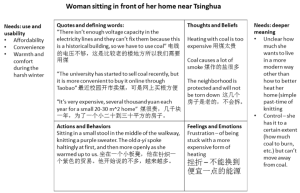Project update from Christina Zhou, Elsa and Noelle Herring
The past few days, we’ve been working to understand the heating situation near Tsinghua University across a variety of building types, ranging from old hutong style buildings to campus coffee shops. Types of technologies we’ve seen range from coal stoves to district heating.
One key interview that stood out was one with an old woman who had lived in the historical preservation buildings near campus. To get her to talk more freely, we focused not only on the logistics of her coal use, but also the feelings involved. She was frustrated with the inconvenience and cost of the coal, on top of the health impacts from breathing in so much smoke the winter. She didn’t like that the building’s historical preservation status meant that it was impossible to redevelop the electricity, which couldn’t handle additional voltage for electric heaters. Moving forward, we will be doing research online (Taobao!) to see prices for coal and get a better sense of building efficiency improvements, and capture additional insights.
这几天,我们对清华附近的供暖情况进行了调查。包括很多不同的建筑类型,比如老的胡同里的供暖情况以及校园里的咖啡厅的供暖情况。他们使用的供暖技术包括:自供暖(小锅炉)以及集中供暖。
其中比较重要的一个访谈是与一个住在学校二校门附近的住户。在访谈中,我们不仅仅关注她是如何使用锅炉进行自供暖的,同时还询问了她对于这种供暖方式的感受。她并不喜欢自己烧锅炉取暖,原因不仅仅是因为买煤非常贵,更重要的原因是自己烧煤会有很多烟,对身体不好,也非常不方便,他们希望可以接受集中供暖,但是由于她所居住的房子是文物保护建筑,所以没有办法进行改造,并且在未来也暂时没有相关的改造计划。往前走,我们要网上查价格和别的保暖的方法,和跟别的人讲话.
